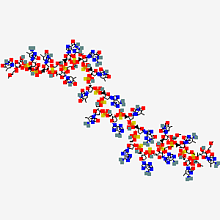Using a Computational Approach to Improve Therapeutic Drug Treatments

Caption: A molecular graphic inotersen, one of the antisense oligonucleotide drugs that will be studied to help improve therapeutic treatments for neuron damage and disease.
Michael Cummings, a professor of biology with an appointment in the University of Maryland Institute for Advanced Computer Studies, is part of a multi-institutional team that will apply powerful computational tools to make new drug therapies more effective.
The two-year project is funded by a $300K grant from the U.S. Food and Drug Administration.
The team, which includes faculty members from the University of Maryland School of Pharmacy and the University of Maryland Institute for Bioscience and Biotechnology Research (IBBR), will analyze the synthetic process that goes into manufacturing antisense oligonucleotides—small pieces of DNA or RNA that can bind to specific molecules of RNA.
These antisense agents can be used in the treatment of various diseases, including neurological disorders, cancer, cardiovascular and metabolic diseases.
Cummings, who is director of the Center for Bioinformatics and Computational Biology, says the synthesis process used to make these drugs results in products of different chemical configurations, termed diastereomers. Existing research has shown that different diastereomer compositions may alter their pharmacological effects, potentially rendering them not as beneficial.
To better understand how the synthesis process may affect the diastereomeric compositions in the drug product, the FDA-funded team will employ a multidimensional analytical approach that computationally integrates state-of-the-art liquid chromatography, mass spectrometry and nuclear magnetic resonance spectroscopy.
Cummings says their research will focus on two specific drugs. One is used to treat children and adults with spinal muscular atrophy, an inherited motor neuron disease that causes skeletal muscle weakness and wasting, which worsens with age. The other is used to treat adults with hereditary transthyretin-mediated amyloidosis, which results in damage of multiple nerves throughout the body.
Cummings will analyze the laboratory results and construct models of the drug synthesis process to better predict diastereomer compositions.
Assisting on the project are Jace Jones, an assistant professor of pharmaceutical sciences and associate director of the Mass Spectrometry Center at the University of Maryland School of Pharmacy; Steven Fletcher, an associate professor of pharmaceutical sciences; and Robert Brinson, a research chemist at IBBR and the National Institute of Science and Technology.
—Story by Melissa Brachfeld
